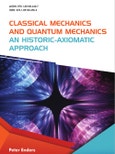This unique textbook presents a novel, axiomatic pedagogical path from classical to quantum physics. Readers are introduced to the description of classical mechanics, which rests on Euler's and Helmholtz's rather than Newton's or Hamilton's representations. Special attention is given to the common attributes rather than to the differences between classical and quantum mechanics. Readers will also learn about Schrödinger's forgotten demands on quantization, his equation, Einstein's idea of ‘quantization as selection problem'.
The Schrödinger equation is derived without any assumptions about the nature of quantum systems, such as interference and superposition, or the existence of a quantum of action, h. The use of the classical expressions for the potential and kinetic energies within quantum physics is justified.
Key features:
- Presents extensive reference to original texts.
- Includes many details that do not enter contemporary representations of classical mechanics, although these details are essential for understanding quantum physics.
- Contains a simple level of mathematics which is seldom higher than that of the common (Riemannian) integral.
- Brings information about important scientists
- Carefully introduces basic equations, notations and quantities in simple steps
This book addresses the needs of physics students, teachers and historians with its simple easy to understand presentation and comprehensive approach to both classical and quantum mechanics.
Table of Contents
Chapter 1
- Introduction
PART I CLASSICAL-MECHANICAL SYSTEMS
Chapter 2
- Newton-Eulerian Axiomatic: The Notion Of State
Chapter 3
- Alternative Axiomatic: Energy Conservation
Chapter 4
- (IM)Possible (Momentum) Configurations
PART II QUANTIZATION AS SELECTION PROBLEM
Chapter 5
- Why Quantum Mechanics?
Chapter 6
- A Hierarchy of Selection Problems
Chapter 7
- Non-Classical Energies
Chapter 8
- Stationary Schrodinger Equation
Chapter 9
- Non-Classical Solution Method
Chapter 10
- Additional Results
PART III QUANTUM DYNAMICS
Chapter 11
- Conservation and Change of Stationary States
Chapter 12
- Equation Of Motion
Chapter 13
- Conservation Laws
Chapter 14
- Applications
PART IV SYMMETRY
Chapter 15
- General Considerations
Chapter 16
- Space-Time Symmetries
Chapter 17
- Gauge Symmetry
Chapter 18
- Permutation Symmetry
Chapter 19
- ‘Aequat Causa Effectum
PART V FIELD QUANTIZATION AS SELECTION PROBLEM
Chapter 20
- Introduction
Chapter 21
- Coupled Classical Oscillators
Chapter 22
- From Chains to Strings
Chapter 23
- Quantization of the String
Chapter 24
- Free Electromagnetic Field
PART VI PROSPECTS
Chapter 25
- Summary And Conclusions
Chapter 26
- Open Questions - Suggestions
Chapter 27
- Points Of Extension or Generalization
References and Further Reading
Subject Index
Samples

LOADING...
Author
- Peter Enders








